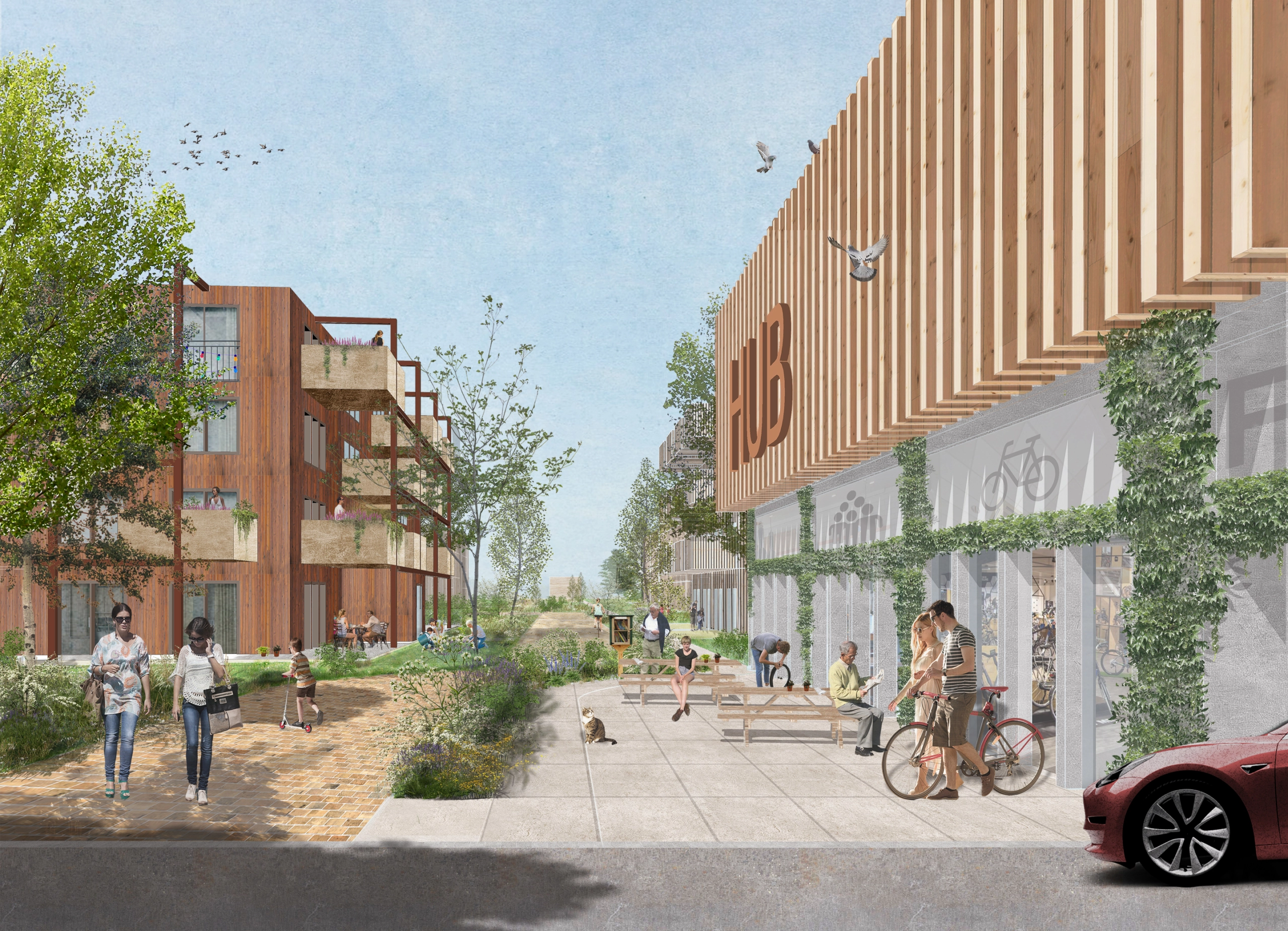
Duurzame stedenbouwkundigen
Froukje: ‘wij zijn een stedenbouwkundig ontwerpbureau. We doen zowel strategische projecten als operationele. We werken graag aan projecten waarbij duurzaamheid hoog in het vaandel staat en waarbij we uitgenodigd worden innovatief te denken om de complexe puzzel van de klimaattransitie en de energietransitie op te lossen. Zo werken we aan duurzame steden.’ Als voorbeeld noemt Froukje de nieuwe wijk Lincolnpark in Hoofddorp. Ze vertelt: ‘voor deze energieneutrale wijk hebben we het stedenbouwkundigplan gemaakt. we hebben de regie op hoe de bebouwing en openbare ruimte eruit moet komen te zien en hoe duurzaamheidsambities worden gerealiseerd.
Onderzoek naar circulaire materialen
‘De hele wijk wordt energieneutraal, wandelen en fietsen wordt in deze wijk aantrekkelijker dan autorijden en we zorgen voor materiaalgebruik met een lage ecologische footprint, zoals hout of hergebruikte materialen.’ Ook gaat het bedrijf aan de slag met een onderzoek naar circulaire materialen. Froukje: ‘welke materialen zijn er beschikbaar, hoe kun je ze gebruiken en vooral: wat is de impact ervan? Dit zetten we in een database en met die informatie voorhanden kunnen we in de toekomst onze voorstellen en ontwerpen steeds duurzamer maken.’
Profijtelijke kennismaking met de CO2-Prestatieladder
Duurzaamheid zit in het DNA van ons bedrijf, vertelt Shirley: ‘aan de keukentafel tijdens de lunch sparren we graag over hoe we persoonlijk en als bedrijf nog duurzamer bezig kunnen zijn. Zo kwam ook de vraag naar voren hoe we onze duurzaamheidsambities konden formaliseren en ons daarmee ook meer kunnen profileren.’ Als antwoord op die vraag koos PosadMaxwan voor de CO2-Prestatieladder, nadat een aanbesteding van provincie Noord-Holland het bedrijf op het bestaan van het instrument wees. Het was een waardevolle kennismaking, want de aanbesteding heeft PosadMaxwan in samenwerking met andere partijen bovendien gewonnen. Froukje: ‘met de CO2-Prestatieladder kunnen wij laten zien dat het ons menens is om CO2 te reduceren en dat wij hier ook in onze projecten aandacht aan besteden.’
Eén derde minder CO2 in vijf jaar
Tijdens het certificeringsproces stellen de stedenbouwkundigen zichzelf ten doel om van 25 ton CO2-uitstoot in 2019 naar 16 ton CO2-uitstoot in 2024 toe te werken, oftewel 33,3% CO2-reductie in vijf jaar. Shirley vertelt hierover: ‘onze grootste uitstoot, de helft, zit in het gebruik van stadswarmte. Het reduceren ervan is een uitdaging, want ons kantoor bevindt zich in een bedrijfsverzamelgebouw, en tot nu toe wordt met een gemiddeld verbruik per m2 gerekend. We zullen dus eerst ons werkelijke verbruik moeten zien te achterhalen, voordat we kunnen laten zien dat we eventueel minder verbruiken. Gelukkig kan dat, we zijn bezig om slimme meters te installeren.’
Van openbaar vervoer tot vegan lunch
Andere maatregelen die PosadMaxwan neemt zijn om alle business travel met het openbaar vervoer te doen, tenzij een plek wel heel slecht bereikbaar is: dan wordt van elektrische deelauto’s gebruikgemaakt. ‘En onze lunch wordt nu helemaal vegan!’ zegt Shirley vrolijk. Het is haar favoriete maatregel. Het is tekenend voor het duurzaamheidsbewustzijn van het bedrijf: het idee om naast vlees nu ook zuivel achterwege te laten, kwam bij de medewerkers zelf vandaan. Ook de andere maatregelen die PosadMaxwan voor de CO2-Prestatieladder neemt, worden in de breedte van het bedrijf gesupport. ‘Om initiatieven zitten we niet verlegen,’ zegt Shirley. ‘Nu nog de uitvoering in de praktijk.’

Afbeelding: de maatregelen die PosadMaxwan neemt in het kader van de CO2-Prestatieladder
Bouwmaterialen als scope 3-emissies
Bij maatregelen rondom de eigen bedrijfsvoering blijft het echter niet, want het bedrijf is op niveau 4 gecertificeerd, wat betekent dat ook de scope 3-emissies worden meegenomen. Maar wat zijn de scope 3-emissies van een stedenbouwkundig bedrijf? Shirley: ‘daar hebben we inderdaad even goed voor achter onze oren moeten krabben, want we produceren geen product en onze werkzaamheden zijn erg uiteenlopend. Maar we hebben besloten om de CO2 die vrijkomt bij de levenscyclus van bouwmaterialen die onze opdrachtgevers gebruiken, te beschouwen als onze scope 3-emissies. Wij hebben als ontwerpers immers invloed op welke bouwmaterialen er gebruikt zullen worden voor een project.’
Schaduwkosten van materialen
Froukje: ‘onze ketenanalyse was een onderzoek naar de schaduwkosten van de verschillende materialen. Dit zijn de kosten van een gebouw, product of project op het milieu – uitgedrukt in een geldwaarde. Nu kunnen we toekomstbestendig advies geven: welke materialen hebben gedurende hun levenscyclus de minste CO2-uitstoot? Welke opties zijn er allemaal en welke optie kunnen we het best in een bepaalde situatie adviseren? We hopen dat aannemers en projectontwikkelaars een beter onderbouwde keuze zullen maken en niet alleen de bouwkosten in overweging nemen. Wij gaan in de nabije toekomst onze ontwerpvoorstellen zoveel mogelijk voorzien van dit advies.’
Toekomst
Froukje: ‘onder de stedenbouwkundigen zien we onszelf als voorlopers in de energie- en klimaattransitie. Die rol willen we blijven houden, hoewel het natuurlijk ook goed nieuws is dat er steeds meer gelijksoortige bedrijven komen die zich hiervoor willen inzetten. Wij blijven ons in elk geval inspannen om complexe vraagstukken om te zetten naar duidelijk te bevatten voorstellen, zodat we opdrachtgevers helpen bij het maken van duurzame keuzes.’ En een niveau 5-certificaat? Zoals we het bedrijf leren kennen, zou dat zeker kunnen. ‘We willen onszelf altijd verbeteren,’ aldus Shirley. Maar eerst zijn alle inspanningen gericht op de maatregelen zelf.
>> Lees meer over het project Lincolnpark in Hoofddorp
>> Bekijk de bedrijfspagina van de certificaathouder en download de ketenanalyse